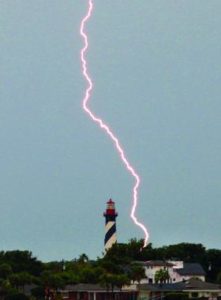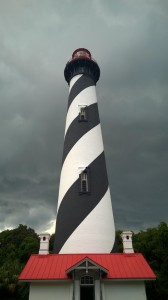Floridians know our state experiences more lightning strikes than any other. Here at the lighthouse, this poses a safety concern. Although it is a myth that lightning ALWAYS strikes the tallest object, because of their height tall objects are much more likely to suffer a strike if lightning is in the area.
Being one of the tallest objects in an area that sees a lot of lightning, the St. Augustine Lighthouse endures its share of strikes. Although the lighthouse is properly grounded to ensure a safe path for the electricity to travel, the structure and mechanisms within have suffered damage from lightning strikes. In 2001, a lightning strike damaged the motor that turns the Fresnel lens in the tower giving the lighthouse its distinctive flash signal, called a nightmark.
Historic Strikes
Of course, lightning strikes are not a modern phenomenon. Between 1898 and 1908, the keepers recorded four lightning strikes in their log, three of which struck the tower while the fourth hit the new Navy Wireless Station built in 1905. The strikes often affected the electrical wiring in the tower in addition to causing structural damage in some cases.
A 10:30am strike on April 24th, 1898 knocked down an electrical wire and destroyed a call bell used to signal the Keepers’ House from the tower. Head Keeper Joseph Rantia records no other damage from this incident. Just over a year later, on May 23rd, 1899 a lightning strike knocked out a newly installed telephone line.
An August 25th, 1906 lightning strike on the Wireless Station “did much damage,” according to the Keepers’ Log, although the brief description does not expound on the type and extent of that damage.
On August 11, 1908, a lightning strike hit the tower and ran along the call bell wires used to communicate between the tower and the house, which in turn “tore out part of [the] front door frame and casing in [the] Assistant Keepers quarters,” though they recorded no damage to the tower during the hair-raising incident.

Lightning doesn’t hit the tallest object every time, but height makes strikes more likely. Photo by Daron Dean/St. Augustine Record
The last recorded lightning strike in our Keepers’ Log is from 1944, which states that “lightning struck the lighthouse, tearing off part of the roof, burning out [the] radio transmitter, melting fuses, and jarring [the] keeper.”
Lighthouse Lightning Safety
The lighthouse is still a frequent target of lightning strikes, and during stormy weather we ensure the safety of our visitors and staff by restricting access to the tower. Tower strikes have been known to knock out phone and electrical systems in our Visitors Center a few hundred feet away.
If you plan to visit the lighthouse, be sure to check the forecast to make sure there is no severe weather predicted. When the tower is closed due to weather, the Keepers’ House remains open for visitors to explore and learn more about all we do here at the lighthouse.


